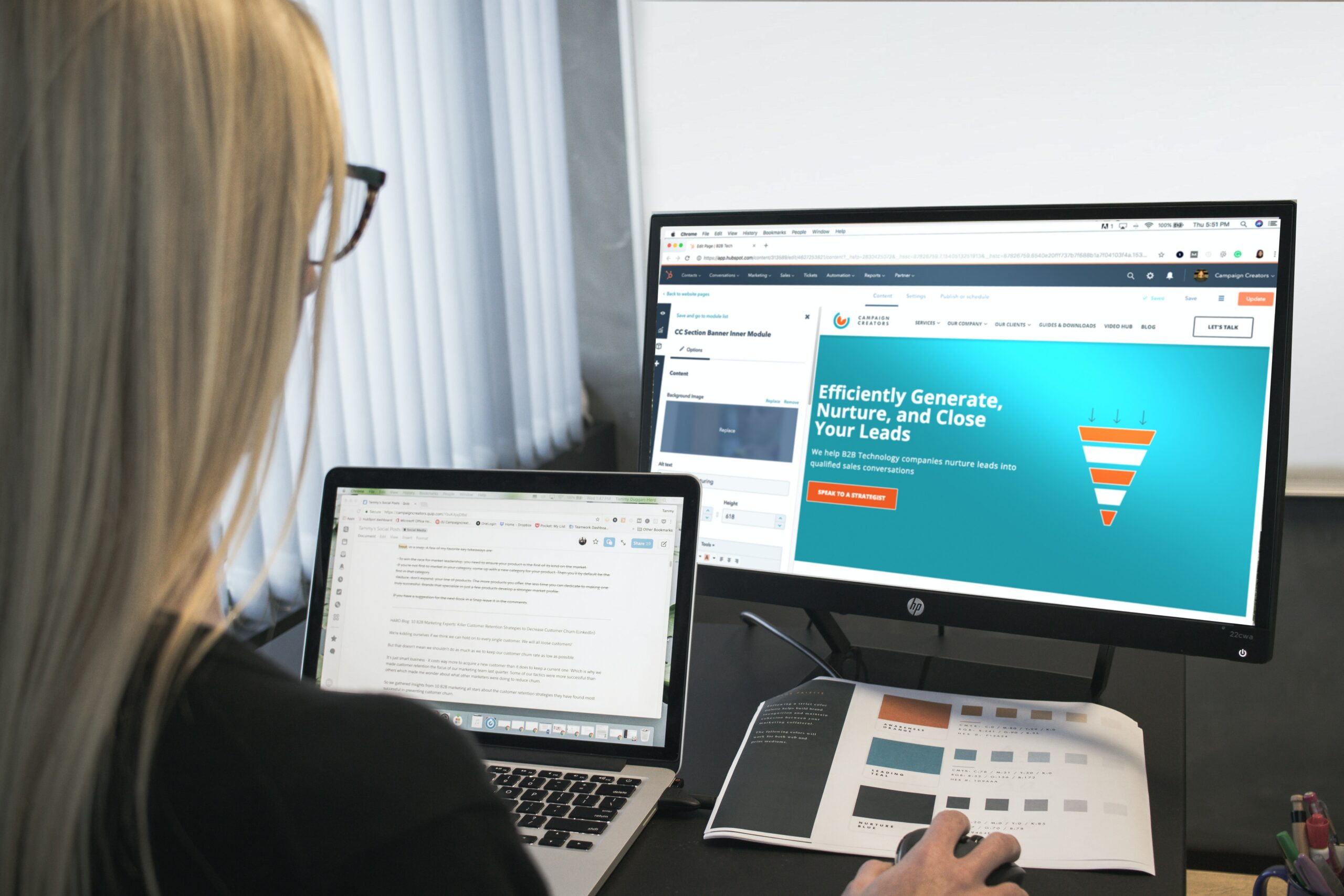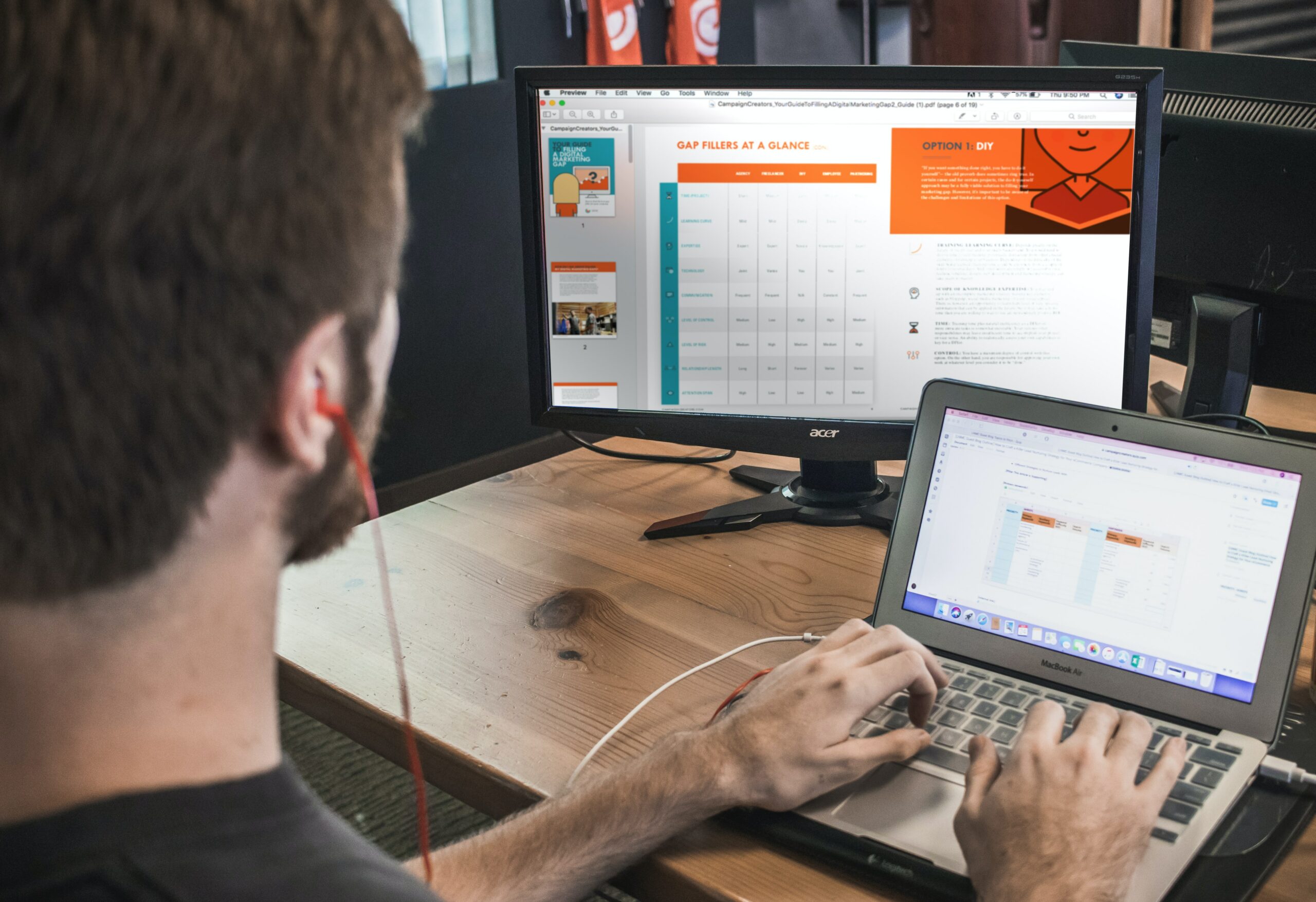On-page SEO involves optimizing web page content for search engines and users. Standard techniques include optimizing title tags, content, internal links, and URLs.
Websites can improve their search engine ranking and visibility by targeting keywords, creating helpful content, utilizing SEO tools, and incorporating responsive design.
The Essence of On-Page SEO
At its core, on-page SEO is about making your website more accessible and understandable to search engines. This involves optimizing various elements of your website that, when combined, can significantly boost your position in search engine results.
These elements range from the content itself to the HTML source code that helps search engines understand what your webpage is about.
On-page optimization is not just about inserting target keywords; it’s about providing helpful content in a user-friendly format.
This includes ensuring your website has a responsive design to cater to mobile users, utilizing SEO tools for keyword research, and optimizing meta tags and images for a comprehensive approach to SEO.
Understanding On-Page SEO and Its Impact
On-page SEO encompasses all measures taken directly within the website to improve its position in the search rankings. This includes optimizing the content and the HTML source code.
Elements of on-page SEO are crucial as they help search engines interpret the subject matter of the content and determine its value to a searcher’s query.
By effectively utilizing on-page strategies, websites can increase their visibility and rank higher for relevant searches. This attracts more visitors and enhances the overall user experience, making it more likely that visitors will engage with the content and convert it into customers or followers.
Distinguishing On-Page, Off-Page, and Technical SEO
On-page SEO refers to strategies applied on the website to directly influence organic traffic, whereas off-page SEO refers to actions taken outside of your website to impact your rankings within search engine results pages.
Technical SEO refers to website and server optimizations that help search engine spiders crawl and index your site more effectively.
The blend of on-page and off-page factors, along with technical SEO, creates a comprehensive SEO strategy that can substantially increase organic traffic.
Understanding the distinctions between each type of SEO helps webmasters prioritize efforts and resources to maximize the impact of their SEO campaigns.
Emphasizing the Importance of On-Page SEO
While many factors contribute to a website’s success, on-page SEO is foundational. It allows search engines to understand your content and rank it accordingly.
An on-page SEO checklist is a guide to optimize all the essential elements, from meta tags to content quality and keyword usage.
This checklist is a vital tool in the SEO arsenal, helping to address each on-page element systematically. Adherence to a thorough on-page SEO checklist can significantly enhance a website’s search engine visibility and user engagement.

Mastering Content Optimization Techniques
Mastering content optimization is key to on-page optimization. It revolves around strategically placing target keywords within helpful content to meet the needs of users and search engines.
By aligning content with user intent, websites can attract more qualified traffic and improve search rankings.
Crafting High-Quality, Engaging Content
The heart of content marketing is creating high-quality content. To engage users and meet search engine standards, it’s essential to incorporate target keywords naturally and produce content that provides value.
This approach satisfies user queries and builds trust and authority in your niche.
Ensuring Content Uniqueness
Uniqueness is key to standing out in the vast sea of online content. Not only does the text need to be original, but images in your content should also add value and be distinctive.
Unique content is more likely to capture the attention of both users and search engines, leading to better engagement and rankings.
Images, in particular, when used effectively, can complement your textual content and provide visual appeal, making your content more engaging and memorable. They also contribute to SEO when tagged with relevant alt text, enhancing your website’s visibility in image searches.
Aligning Content with Search Intent
High-quality content is most effective when it aligns with your audience’s search intent. Understanding what users are looking for and delivering content that meets those needs ensures that your content resonates with your target audience, leading to increased engagement and conversions.
When content matches user intent, it is more likely to be shared and referenced, which can improve its authority and relevance in the eyes of search engines. This alignment is a critical component of on-page SEO and contributes to the overall success of your SEO efforts.
Maintaining Content Freshness
Maintaining content freshness is crucial for maintaining and improving Google rankings. Regularly updated content signals to search engines that your website is relevant and provides up-to-date information, which is key for maintaining and improving rankings over time.
Top-ranking pages often feature comprehensive, current content. Periodic on-page SEO audits can identify opportunities to refresh content, potentially including rich snippets in search results, which can further enhance visibility and click-through rates.
Utilizing Strategic Keyword Placement
Strategic keyword placement involves integrating your target keywords naturally within the first 100 words of your content, in the alt text, page meta descriptions, and throughout the body where it naturally appears.
This deliberate approach helps align content with the intention behind user searches.
Keyword Research Fundamentals
Keyword research is the foundation of crafting high-quality content. It involves identifying relevant keywords that users are searching for and incorporating them into your page content. This process ensures your content resonates with your audience and satisfies their informational needs.
Focusing on relevant keywords also helps create content likely to rank well in search engines. By targeting the right keywords, you can attract more qualified traffic to your website, which is the ultimate goal of any SEO strategy.
Including Keywords in the First 100 Words
Including your main keywords within the first 100 words of your content is a critical on-page SEO tactic. This early placement helps search engines quickly understand the primary focus of your page, which can positively influence how your content is indexed and ranked.
This strategy also ensures that readers immediately see the content’s relevance to their search query, which can increase engagement and reduce bounce rates. A clear and early focus on the target keywords sets the stage for the rest of the content and aids in user navigation.
Balancing Keyword Frequency
Balancing keyword frequency is essential to avoid the pitfalls of keyword stuffing, which can harm your SEO efforts. Instead, aim to naturally include keywords, complemented by synonyms and related phrases, to maintain readability and relevance.
Alt text for images should also contain relevant keywords, as it contributes to SEO and accessibility. However, it’s crucial to use alt text judiciously and ensure it accurately describes the image content for the best user experience.
Enhancing HTML Elements
Enhancing HTML elements is a fundamental aspect of on-page SEO. By optimizing your title tags and meta descriptions, you provide clear and concise information about the content of your web pages.
This can significantly improve your website’s visibility in search engine results pages.
Page Titles and Meta Descriptions Optimization
Optimizing page titles and page meta descriptions are critical on-page SEO factors that influence how search engines and users alike perceive an existing page.
A well-crafted page title should accurately and concisely reflect the content, while the meta description provides a summary enticing users to click through.
Aim to keep your meta descriptions between 155-160 characters to ensure they display properly in search results.
Writing Compelling Page Titles
Page titles are users’ first impression of your content in search engine results, so making them compelling is crucial. They should be descriptive and include primary keywords to improve visibility. Remember, titles help users understand what the page is about and play a pivotal role in search rankings.
When crafting page titles, it’s essential to balance brevity with descriptiveness. Each title should be unique, reflecting the page’s specific content, and ideally include the brand name for recognition.
A compelling page title can significantly affect click-through rates and overall page performance.
Crafting Unique Meta Descriptions With Keywords
While meta descriptions don’t directly influence rankings, they are vital for click-through rates. Each description should be unique, incorporating relevant keywords without stuffing.
This snippet of text acts as an ad copy, persuading users that the page contains the information they seek.
Meta descriptions should encourage users to click on your link by using active voice and a compelling call to action. Keyword research tools can help find the right terms that reflect user intent and can be naturally integrated into the meta description, enhancing its effectiveness in attracting users.
Headers and Structured Data
Organizing content with hierarchical headings is essential for both user experience and SEO. Headers help break down content into digestible sections, making it easier for users to scan and for search engines to understand the structure.
Additionally, implementing schema markup for rich snippets can enhance visibility in search results, providing users with a snapshot of what to expect on the page.
Organizing Content With Hierarchical Headings
Using headers, such as H1, H2, H3, etc., helps organize the content logically and makes it more accessible. The H1 tag should be used for the main title, with subsequent headings introducing different sections.
Including images in your content, properly tagged and described, adds visual appeal and contributes to the content’s organization and accessibility.
Properly structured headings guide the reader through your page’s narrative while also giving search engines clear signals about the hierarchy and relevance of the content. This can help improve the page’s organization and, consequently, its rankings.
Implementing Schema Markup for Rich Snippets
Rich snippets, generated by schema markup, provide a competitive edge by enhancing the appearance of your page in search results. They offer a visual layer that can increase click-through rates by offering immediate information, such as ratings, price ranges, or availability.
Schema markup is a form of microdata that you add to your pages’ HTML to create an enhanced description (a rich snippet) that appears in search results.
Applying this markup is an advanced technique for communicating with search engines, providing more precise context about the page’s content and purpose.

Improving User Experience (UX) and Accessibility
User experience and accessibility are fundamental components of a successful website. They contribute to customer satisfaction and are significant factors in search engine rankings.
Improving these aspects involves ensuring fast page load speed and mobile responsiveness and optimizing visual elements for a seamless and inclusive user journey.
Prioritizing Page Load Speed
Page loading speed is vital to a website’s usability and SEO performance. Slow-loading pages can lead to increased bounce rates and diminished user satisfaction.
Compelling content loses effectiveness if users leave before it loads, emphasizing the importance of optimizing for speed.
To enhance page loading speed, consider optimizing image sizes, leveraging browser caching, and minimizing the use of heavy scripts. Faster loading times improve user experience, leading to better engagement, higher retention, and increased conversions.
Ensuring Mobile Responsiveness
With most internet traffic from mobile devices, ensuring your website is mobile-friendly is non-negotiable. A responsive design adapts the layout to the viewing environment, providing an optimal experience across various devices.
Mobile responsiveness not only caters to user convenience but also contributes to SEO. Search engines like Google prioritize mobile-friendly websites in their rankings.
Therefore, optimizing for mobile is essential for user engagement and search visibility.
Optimizing Visual Elements
Visual elements play a crucial role in a website’s user experience. Optimizing page titles, page URLs, and visual elements like images and videos is essential for both accessibility and SEO.
Each image should have descriptive alt text, and every page should have a unique H1 per page to communicate the topic to search engines and users.
Compressing Images for Faster Loading
Large image files can significantly slow down page loading times. Compressing images before uploading them to your website can help speed up load times without compromising quality.
Additionally, make sure to include relevant alt text for each image to improve SEO and provide context for users who cannot view them.
Leveraging Alt-Text for Image SEO
Alt text is a critical component for images, serving a dual purpose: it describes the image’s content for search engines, contributes to image SEO, and describes visually impaired users. Accurate and descriptive alt text can improve the accessibility of your visual content and enhance its relevance in search results.
Structuring URLs and Navigation
A carefully structured URL and intuitive navigation system are foundational to a user-friendly website. They guide users through your content and help search engines understand and rank your pages.
A well-organized navigation structure can lead to a better user experience and contribute to SEO performance.
The Anatomy of a Search-Friendly URL
SEO-friendly URLs are clear, concise, and include relevant keywords. They should be structured in a way that is easy for users and search engines to understand. Including categories and a breadcrumb structure can help users navigate your site and improve the overall coherence of your URL structure.
Internal and External Linking Strategies
Effective linking strategies can boost a website’s presence on search engine results pages. Internal linking for SEO helps distribute page authority throughout your site and encourages users to explore more content.
Aim for a moderate number of links per page to maintain user focus and potentially increase the conversion rate. Moreover, linking to authoritative external sources can enhance the credibility of your content and provide additional value to users.
Always ensure that the target page is relevant and provides a positive experience for users following the link.
Adding Relevant Internal Links
Embedding relevant internal links within on-page SEO elements is a strategic move that enhances user engagement and strengthens the SEO of a single page. Internal links guide visitors to other website sections, increasing their time on your site and reducing bounce rates.
Employing an on-page SEO template for internal linking ensures consistency and helps distribute page authority throughout your site.
Citing Authoritative External Sources
While on-page SEO focuses on elements within your site, citing authoritative external sources can boost your page’s credibility. Linking to reputable sites not only provides your readers with additional valuable information but also signals to search engines that your content is well-researched and trustworthy.
This practice can lend authority to your site and is essential to a well-rounded on-page SEO strategy.
On-Page SEO for Enhanced Click-Through Rates (CTR)
Adopting effective on-page SEO techniques is crucial for improving rankings and enticing users to click through to your website. Higher click-through rates (CTR) from search results can increase traffic and potentially higher conversions, making on-page optimization a critical factor in digital marketing success.
Meta Descriptions With a Call to Action
While not a direct ranking factor, meta descriptions play a vital role in motivating users to click through to your website. A compelling meta description should include a call to action, encouraging users to take the next step.
Crafting these snippets carefully can boost your on-paSEOseo and entice users to choose your page over others in the search results.
Title Tag Tweaks for Increased Engagement
Title tags are among the most important on-page SEO elements, and tweaking them for increased engagement is an art. Incorporating powerful words can captivate attention while ensuring the title is accessible to screen readers, which broadens your audience.
A well-crafted title tag can distinguish between a user clicking on your result and a competitor’s.
Using Emotional Triggers in Titles
Using powerful words in titles can evoke an emotional response, compelling users to click. These solid and descriptive words tap into the reader’s emotions, making the content more appealing.
When a title resonates on an emotional level, it can significantly increase the likelihood of engagement and shares, amplifying the reach of your content.
Including the Current Year in Titles and Descriptions
Including the current year in your titles and descriptions can signal to users that your content is up-to-date and relevant.
This simple tactic reassures users that the information they’re about to read is current, which can be especially important for topics that are time-sensitive or rapidly evolving. Thus, it enhances the click-worthiness of your content.

Advanced On-Page SEO Techniques
Advanced on-page SEO techniques go beyond the basics to fine-tune your website’s optimization. These methods leverage the latest best practices to align content for search engines and users, ensuring your site stays competitive.
Following the ultimate guide to on-page SEO can help you uncover these advanced strategies for maximum impact.
Leveraging User Comments for SEO
User comments can be a goldmine for SEO, as they provide fresh, keyword-rich content and encourage community engagement. When users contribute to the conversation, they often use language similar to that of other searchers, which can improve your page’s relevance and visibility.
Encouraging comments and actively participating in discussions can amplify the reach of your content.
Furthermore, analyzing comments can provide insights into your audience’s needs and preferences, guiding the creation of future content that directly addresses their questions.
This user-generated content strategy can be a potent addition to your on-page SEO arsenal, fostering a loop of engagement and optimization.
Optimize for Voice Search and Featured Snippets
Optimizing for voice search and featured snippets has become essential as more users turn to voice-activated devices. Structuring content to appear in these organic results can boost visibility, especially for mobile version searches.
Optimizing images with descriptive filenames also helps secure these coveted spots in search results.
Addressing E-E-A-T Signals
Addressing Expertise, Authoritativeness, Trustworthiness, and Experience (E-E-A-T) signals in your content can significantly improve its perceived value. Demonstrating these qualities through well-researched, authoritative content can influence user perception and search engine rankings, as engines favor sources that exhibit high E-E-A-T.
Formatting for Featured Snippets Inclusion
Featured snippets provide a unique opportunity to gain visibility in search results. Formatting your content to answer questions directly and succinctly can increase the likelihood of inclusion in these snippets.
Utilizing lists, tables, and clear, concise answers can make your content more attractive to search engines for these exceptional organic results.
Consolidating Your On-Page SEO Efforts
Consolidating your on-page SEO efforts can streamline the optimization process, ensuring that every element of your website works towards the same goal. A cohesive strategy can improve not only individual page performance but also your site’s overall authority and ranking potential.
This holistic approach is key to achieving long-term success in search rankings.
By integrating various on-page tactics, from content optimization to HTML element enhancement, you create a robust framework for your site’s SEO. This comprehensive approach can help you navigate the complexity of search algorithms and maintain a competitive edge in the digital landscape.
The On-Page SEO Checklist to Keep You on Track
An on-page SEO checklist serves as a roadmap to optimize your page effectively. This tool helps you cover all the essential steps, from keyword optimization to mobile responsiveness.
Referring to this checklist regularly ensures that you’re not missing any critical components that could impact your site’s performance in search results.
The checklist can also help maintain consistency across your site’s pages, which is vital for user experience and search engine crawling. Applying the best practices outlined in the checklist can confidently enhance your site’s on-page SEO and improve its visibility and ranking.
Regular Monitoring and Updating of On-Page Elements
Regular monitoring and updating of on-page elements, such as page titles, are essential for maintaining SEO performance. The digital landscape is dynamic, with frequent algorithm updates and changing user behavior.
Staying vigilant and making timely adjustments to on-page SEO elements can help your site adapt to these changes and remain competitive.
Performing Periodic SEO Audits
Conducting periodic SEO audits is crucial for maintaining and improving a website’s health. Webmasters can identify and rectify issues that hinder performance by systematically reviewing on-page factors.
Audits typically include assessing the effectiveness of target keywords, checking for broken links, evaluating meta tags, and ensuring that all content is optimized for search engines. Regular audits help keep up with the ever-evolving algorithms, ensuring that a website remains competitive in search engine rankings.
On-Page SEO Tools and Resources
A suite of SEO tools and resources dramatically facilitates effective on-page optimization. These tools offer insights into a website’s performance, such as keyword rankings, content quality, and backlink profiles.
With the right tools, webmasters can streamline their SEO efforts, monitor changes, and make data-driven decisions to enhance their site’s visibility and user engagement.
Resources such as blogs, webinars, and forums are vital in keeping SEO practitioners up-to-date with the latest best practices and trends.
Access to expert guidance and community support empowers website owners to continually refine their on-page SEO strategies and overcome challenges as they arise.
Utilizing SEO Tools for Effective On-Page Optimization
SEO tools are indispensable for effective on-page optimization. They offer precise analytics and actionable insights, helping webmasters track the performance of target keywords, analyze competitors, and identify areas for improvement.
These tools often have features that simplify tasks like keyword research, on-page content analysis, and technical SEO audits, making them a fundamental component of any SEO strategy.
SEO Software and Plugin Recommendations
Specific software and plugins stand out for their effectiveness when it comes to on-page SEO. For WordPress users, plugins like Rank Math and All in One SEO Pack are renowned for their user-friendly interface and comprehensive features.
SEO software like SEMrush, Ahrefs, and Moz offers more advanced functionalities, including keyword tracking, site audits, and competitive analysis. These tools are pivotal for optimizing a website’s on-page elements and improving its visibility in search engine rankings.

Learning and Growing With On-Page SEO
Mastering on-page SEO is an ongoing journey, as search engine algorithms and best practices are constantly changing. Continual learning is imperative for staying ahead of the curve.
Webmasters and marketers must embrace a growth mindset, seeking new knowledge and adapting their techniques to keep pace with the evolution of the digital landscape.
Dedicating time to learning can pay off significantly in terms of a website’s performance. By acquiring new skills and understanding, one can implement more effective strategies that drive traffic, engage users, and convert visits into meaningful actions.
On-Page SEO Video Tutorials and Guides
Video tutorials and guides are excellent resources for visual learners seeking to enhance their on-page SEO skills. These materials often break down complex concepts into digestible, step-by-step instructions.
Whether it’s mastering the art of optimizing for long-tail keywords or understanding how to structure a page for better engine rankings, video content can provide the clarity and guidance necessary for effective implementation.
Conversely, guides offer detailed written instructions and can serve as a reference for SEO practitioners. They often include examples, best practices, and tips that can be revisited. Video tutorials and written guides form a comprehensive learning foundation for on-page SEO.
Community Discussions and Expert Advice
Engaging with the SEO community and heeding expert advice is invaluable for anyone looking to excel in on-page SEO. Community forums, social media groups, and industry conferences provide discussion, problem-solving, and networking platforms with peers and thought leaders.
These interactions can offer fresh perspectives, practical tips, and encouragement, helping to refine strategies and foster professional growth within the field of SEO.
Wrap-Up
On-page SEO is about harnessing strategies that optimize individual web pages to rank higher in search engines. When Google understands a page’s content, it is more likely to display it in response to relevant queries.
This involves meticulous work on elements such as h2 headers, which guide users and search engines through the content’s hierarchy. An h2 header that accurately describes the subsequent section is critical in helping pages rank for targeted keywords.


